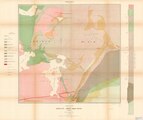Sudbury Basin
The Sudbury Basin [1] is a major geologic structure in Ontario, Canada. It is the second-largest verified impact crater on Earth, as well as one of the oldest.[2][3]
The basin is on the Canadian Shield in the city of Greater Sudbury, Ontario. The Sudbury Basin is referred to locally as "The Valley". The urban core of the former city of Sudbury lies on the southern outskirts of the basin.
The Sudbury Basin is near a number of other geological structures. None of the structures are directly related to each other in the sense of coming from the same geophysical processes.
Formation
The Sudbury basin was formed by a strike from a bolide about 10–15 km (6.2–9.3 mi) in diameter. It occurred 1.849 billion years ago in the Palaeoproterozoic era.[4]
Debris from the impact was scattered over an area of 1,600,000 km2 (620,000 sq mi) and traveled over 800 km (500 mi) away — rock fragments ejected by the impact have been found as far as Minnesota.[5]
With such a large impact, debris was most likely scattered globally,[6] but has since been worn away. Its present size is believed to be a smaller portion of a 250 km (160 mi) round crater that the bolide originally created.
Subsequent geological processes have deformed the crater into the current smaller oval shape. Sudbury Basin would then be the second-largest crater on Earth, after the 300 km (190 mi) Vredefort crater in South Africa, and larger than the 170 km (110 mi) Chicxulub crater in Yucatán, Mexico.
Structure

The full extent of the Sudbury Basin is 62 km (39 mi) long, 30 km (19 mi) wide and 15 km (9.3 mi) deep, although the modern ground surface is much shallower.
Sudbury Basin Media
Shatter cone from Sudbury Impact Structure, Cleveland Museum of Natural History
Rich ore sample from Sudbury, collected in 1932: Pentlandite – Chalcopyrite – Pyrrhotite
References
- ↑ Also known as 'Sudbury Structure' or the 'Sudbury Nickel Irruptive'
- ↑ Verified: means we know it was an impact crater
- ↑ "Deep Impact – Sudbury. Earth Impact Database". Archived from the original on 2016-03-03. Retrieved 2012-04-23.
- ↑ Davis D. 2008. Sub-million-year age resolution of Precambrian igneous events by thermal extraction-thermal ionization mass spectrometer Pb dating of zircon: Application to crystallization of the Sudbury impact melt sheet. Geology.
- ↑ Associated Press: "Ontario crater debris found in Minn." Star Tribune, July 15, 2007
- ↑ Melosh J. 1989. Impact cratering: a geologic process. Oxford University Press.






